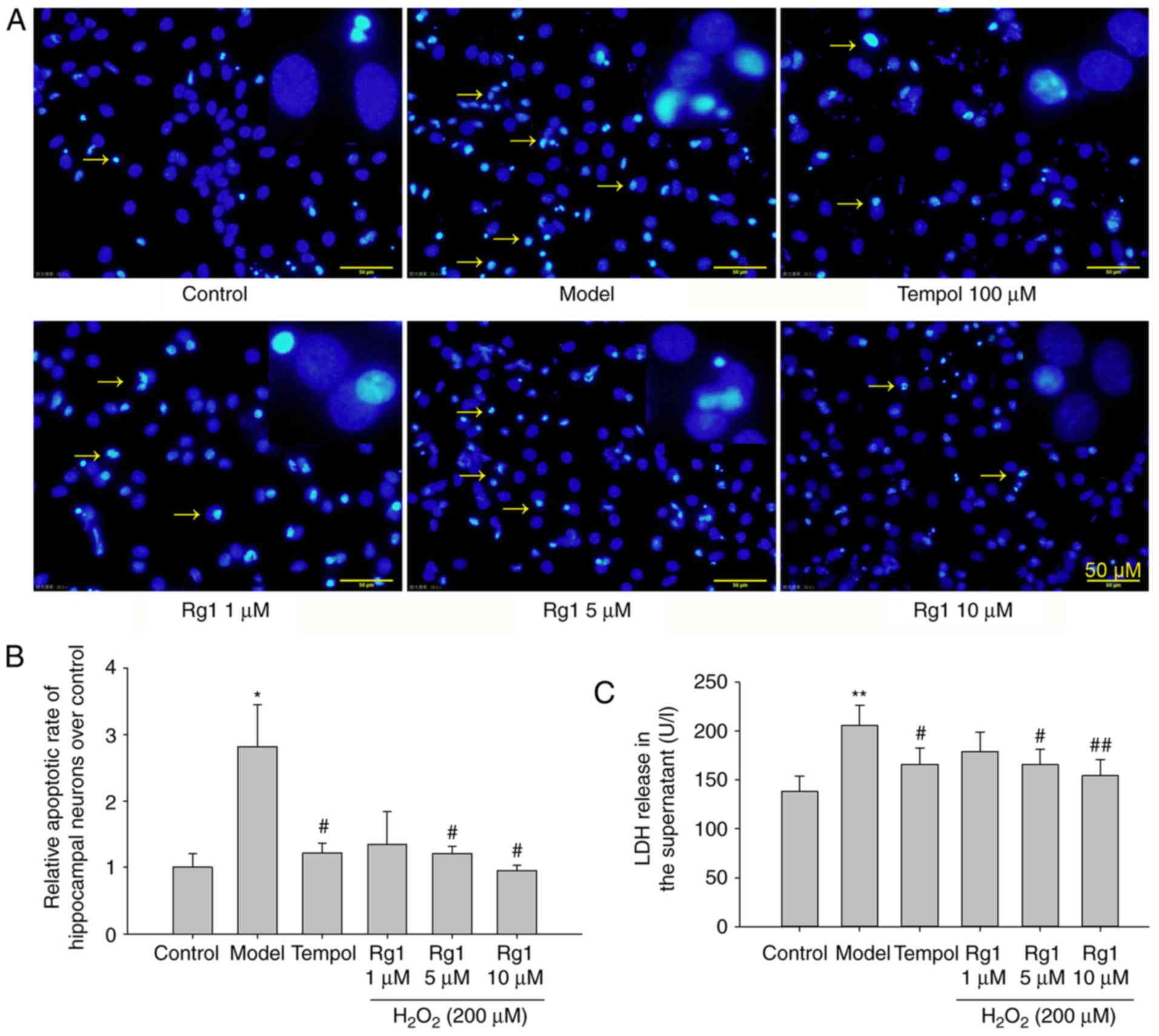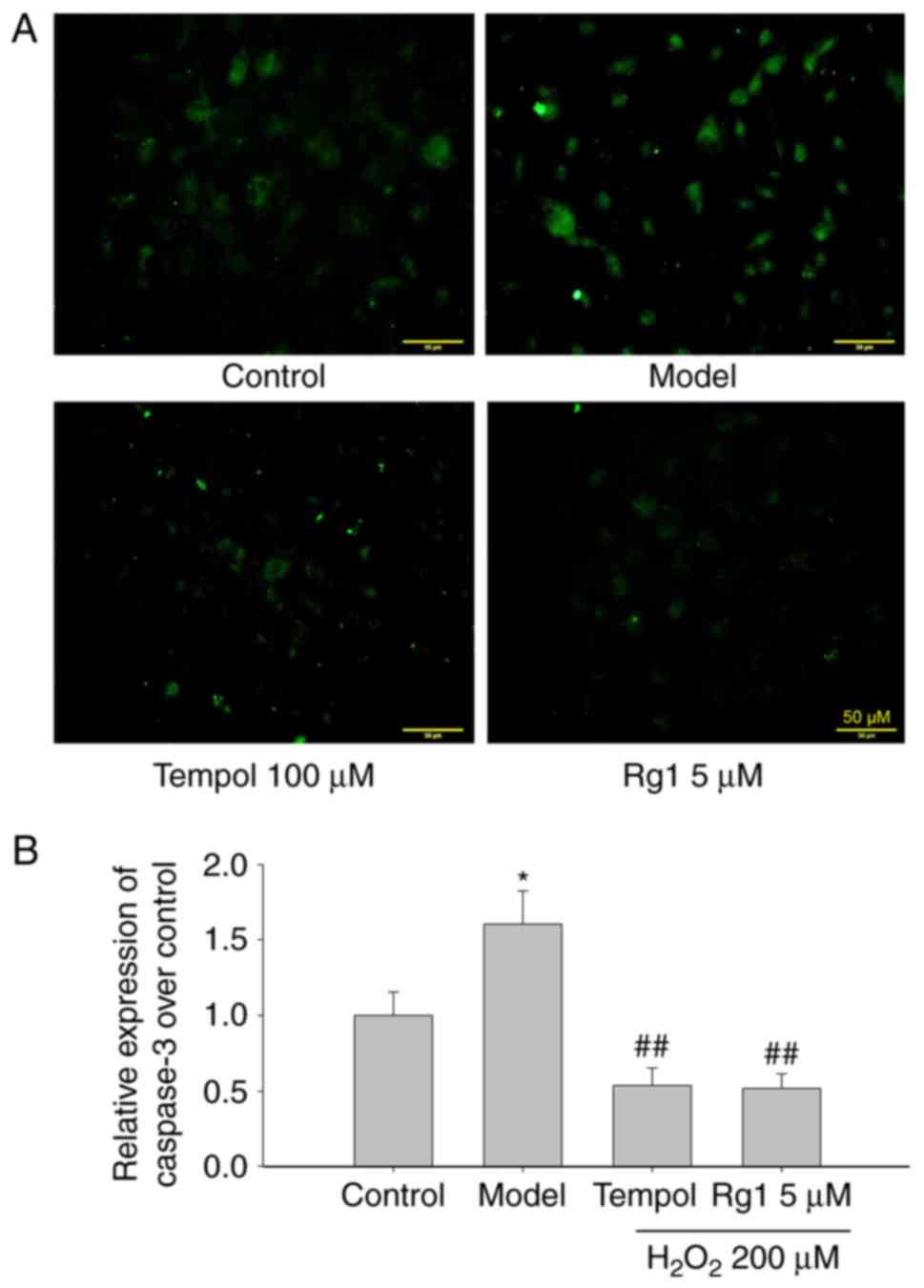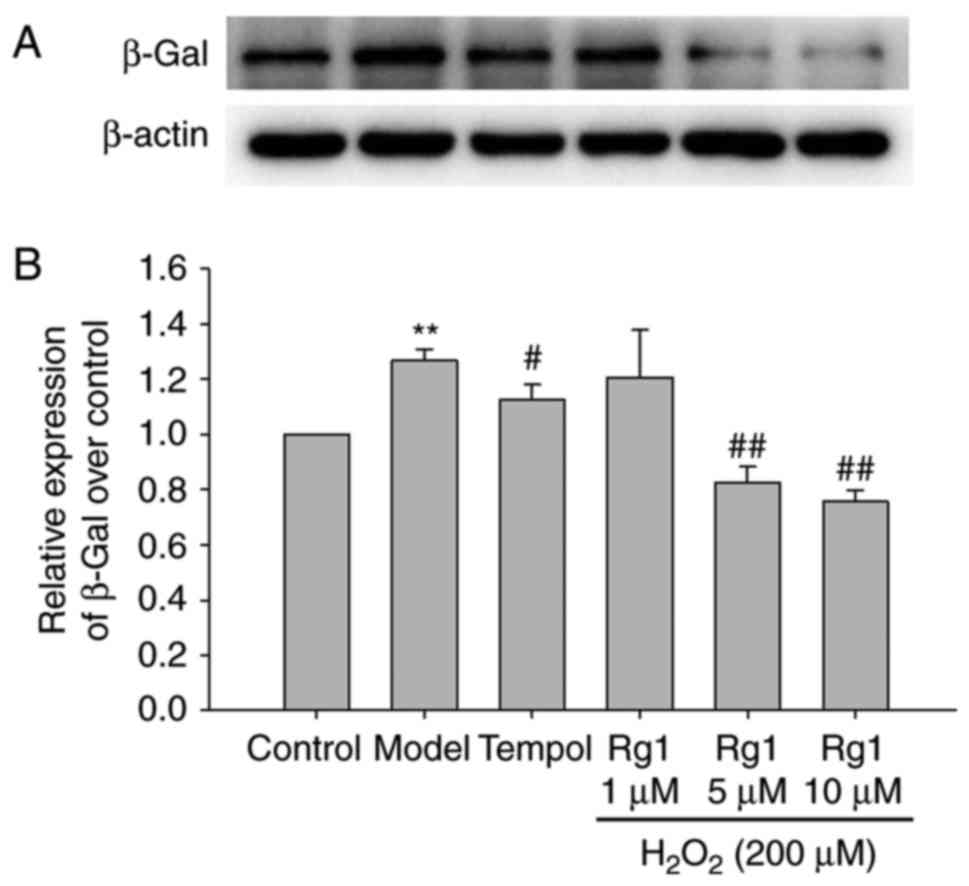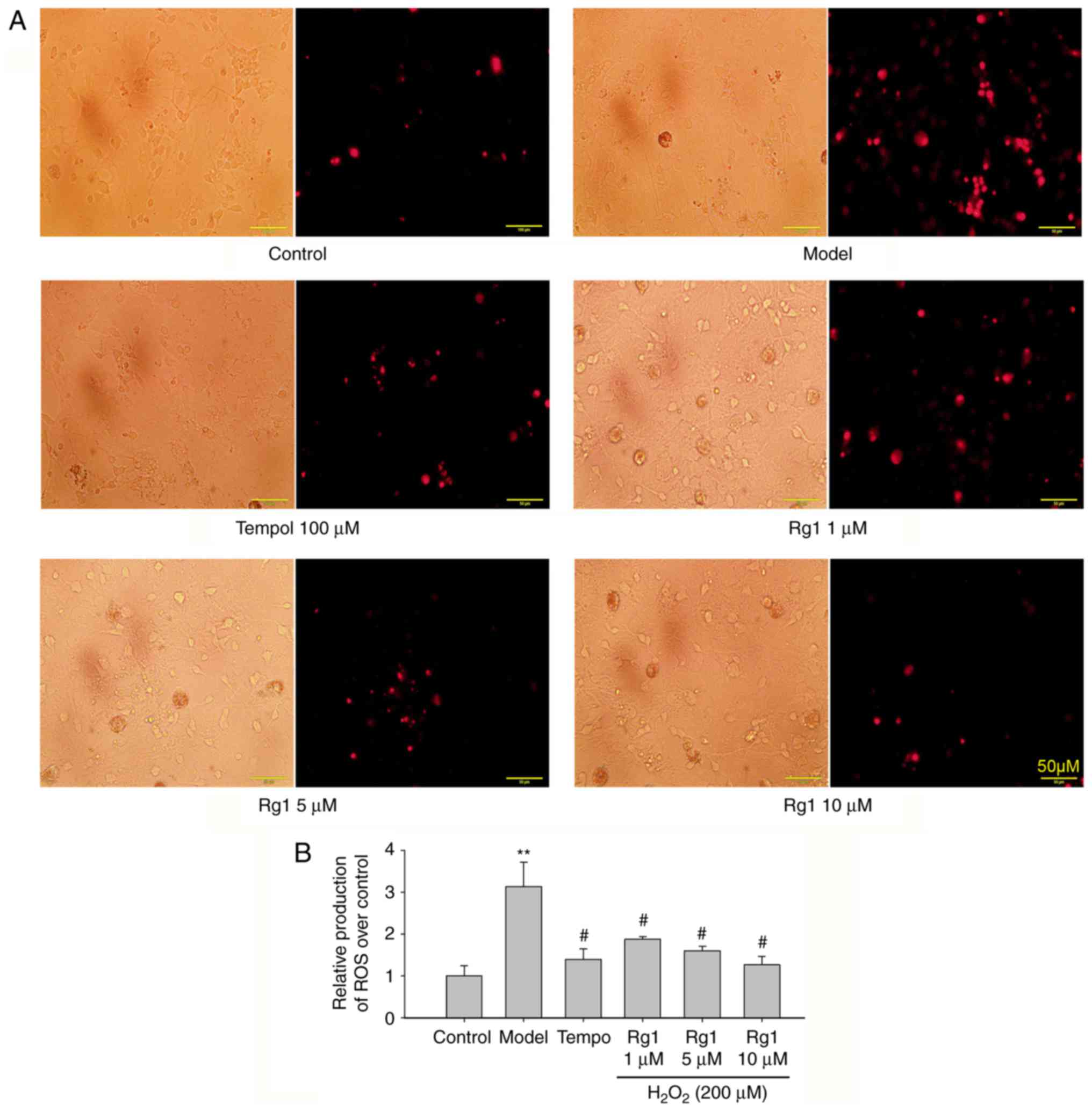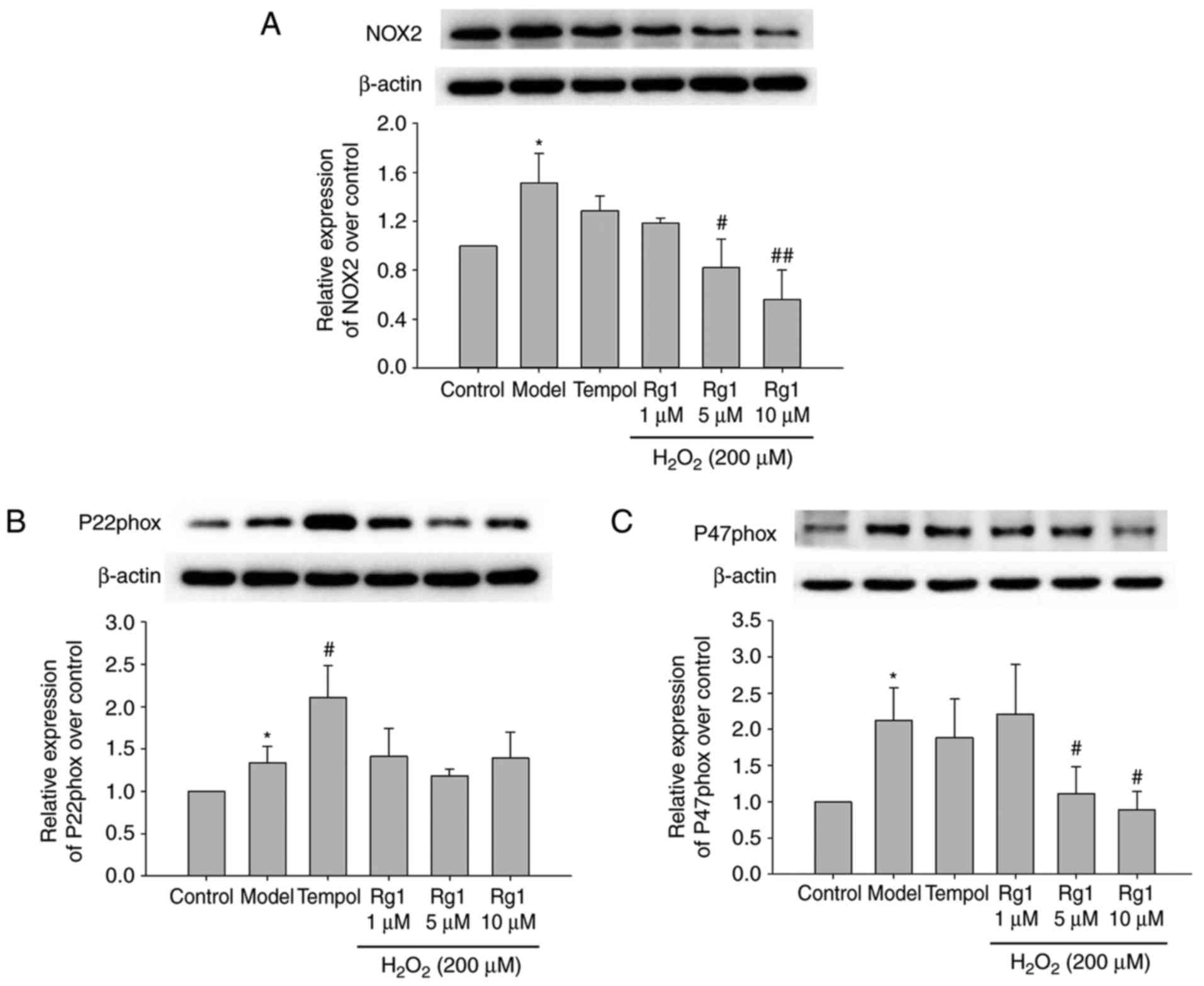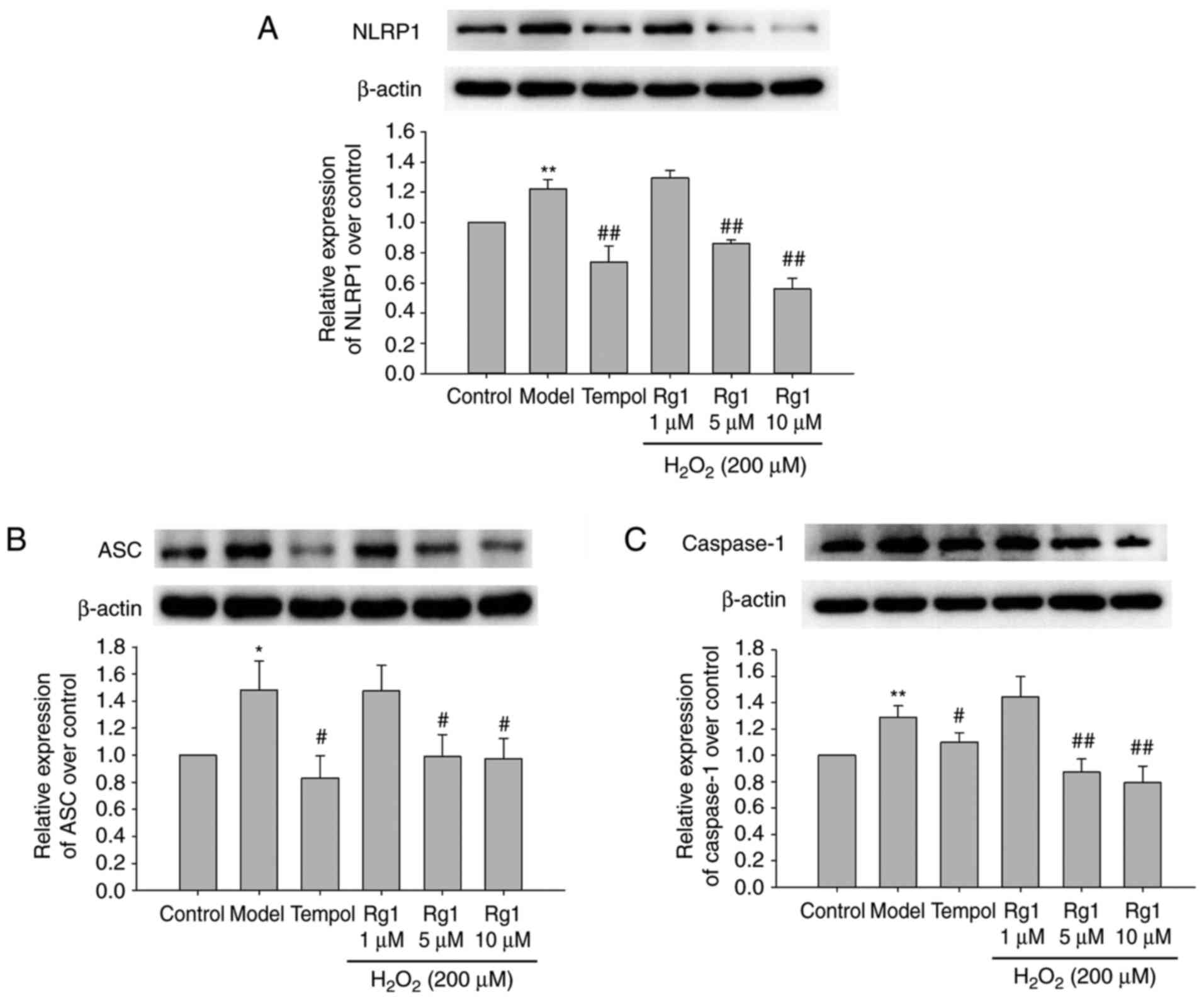|
1
|
Floyd RA and Hensley K: Oxidative stress
in brain aging. Implications for therapeutics of neurodegenerative
diseases. Neurobiol Aging. 23:795–807. 2002. View Article : Google Scholar : PubMed/NCBI
|
|
2
|
Joseph JA, Shukitt-Hale B, Casadesus G and
Fisher D: Oxidative stress and inflammation in brain aging:
Nutritional considerations. Neurochem Res. 30:927–935. 2005.
View Article : Google Scholar : PubMed/NCBI
|
|
3
|
Calabrese V, Cornelius C, Mancuso C,
Lentile R, Stella AM and Butterfield DA: Redox homeostasis and
cellular stress response in aging and neurodegeneration. Methods
Mol Biol. 610:285–308. 2010. View Article : Google Scholar
|
|
4
|
Fan LM, Cahill-Smith S, Geng L, Du J,
Brooks G and Li JM: Aging-associated metabolic disorder induces
Nox2 activation and oxidative damage of endothelial function. Free
Radic Biol Med. 108:940–951. 2017. View Article : Google Scholar : PubMed/NCBI
|
|
5
|
Ansari MA and Scheff SW: NADPH-oxidase
activation and cognition in Alzheimer disease progression. Free
Radic Biol Med. 51:171–178. 2011. View Article : Google Scholar : PubMed/NCBI
|
|
6
|
Rehman SU, Shah SA, Ali T, Chung JI and
Kim MO: Anthocyanins reversed d-galactose-induced oxidative stress
and neuroinflammation mediated cognitive impairment in adult rats.
Mol Neurobiol. 54:255–271. 2017. View Article : Google Scholar
|
|
7
|
Zotova E, Bharambe V, Cheaveau M, Morgan
W, Holmes C, Harris S, Neal JW, Love S, Nicoll JA and Boche D:
Inflammatory components in human Alzheimer’s disease and after
active amyloid-β42 immunization. Brain. 136:2677–2696. 2013.
View Article : Google Scholar : PubMed/NCBI
|
|
8
|
Kaushal V, Dye R, Pakavathkumar P, Foveau
B, Flores J, Hyman B, Ghetti B, Koller BH and LeBlanc AC: Neuronal
NLRP1 inflammasome activation of Caspase-1 coordinately regulates
inflammatory interleukin-1-beta production and axonal
degeneration-associated Caspase-6 activation. Cell Death Differ.
22:1676–1686. 2015. View Article : Google Scholar : PubMed/NCBI
|
|
9
|
Zhang B, Zhang Y, Xu T, Yin Y, Huang R,
Wang Y, Zhang J, Huang D and Li W: Chronic dexamethasone treatment
results in hippocampal neurons injury due to activate NLRP1
inflam-masome in vitro. Int Immunopharmacol. 49:222–230. 2017.
View Article : Google Scholar : PubMed/NCBI
|
|
10
|
Faustin B, Lartigue L, Bruey JM, Luciano
F, Sergienko E, Bailly-Maitre B, Volkmann N, Hanein D, Rouiller I
and Reed JC: Reconstituted NALP1 inflammasome reveals two-step
mechanism of caspase-1 activation. Mol Cell. 25:713–724. 2007.
View Article : Google Scholar : PubMed/NCBI
|
|
11
|
Mawhinney LJ, de Rivero Vaccari JP, Dale
GA, Keane RW and Bramlett HM: Heightened inflammasome activation is
linked to age-related cognitive impairment in fischer 344 rats. BMC
Neurosci. 12:1232011. View Article : Google Scholar : PubMed/NCBI
|
|
12
|
Choi AJ and Ryter SW: Inflammasomes:
Molecular regulation and implications for metabolic and cognitive
diseases. Mol Cells. 37:441–448. 2014. View Article : Google Scholar : PubMed/NCBI
|
|
13
|
Moon JS, Nakahira K, Chung KP, DeNicola
GM, Koo MJ, Pabón MA, Rooney KT, Yoon JH, Ryter SW, Stout-Delgado H
and Choi AM: NOX4-dependent fatty acid oxidation promotes NLRP3
inflammasome activation in macrophages. Nat Med. 22:1002–1012.
2016. View Article : Google Scholar : PubMed/NCBI
|
|
14
|
Yang L, Zhang J, Zheng K, Shen H and Chen
X: Long-term ginsenoside Rg1 supplementation improves age-related
cognitive decline by promoting synaptic plasticity associated
protein expression in C57BL/6J mice. J Gerontol A Biol Sci Med Sci.
69:282–294. 2014. View Article : Google Scholar
|
|
15
|
Sun XC, Ren XF, Chen L, Gao XQ, Xie JX and
Chen WF: Glucocorticoid receptor is involved in the neuroprotective
effect of ginsenoside Rg1 against inflammation-induced dopaminergic
neuronal degeneration in substantia nigra. J Steroid Biochem Mol
Biol. 155:94–103. 2016. View Article : Google Scholar
|
|
16
|
Attele AS, Wu JA and Yuan CS: Ginseng
pharmacology: Multiple constituents and multiple actions. Biochem
Pharmacol. 58:1685–1693. 1999. View Article : Google Scholar : PubMed/NCBI
|
|
17
|
Zhu J, Mu X, Zeng J, Xu C, Liu J, Zhang M,
Li C, Chen J, Li T and Wang Y: Ginsenoside Rg1 prevents cognitive
impairment and hippocampus senescence in a rat model of
D-galactose-induced aging. PLoS One. 9:e1012912014. View Article : Google Scholar : PubMed/NCBI
|
|
18
|
Zhu G, Wang Y, Li J and Wang J: Chronic
treatment with ginsenoside Rg1 promotes memory and hippocampal
long-term potentiation in middle-aged mice. Neuroscience.
292:81–89. 2015. View Article : Google Scholar : PubMed/NCBI
|
|
19
|
Wang Y, Kan H, Yin Y, Wu W, Hu W, Wang M
and Li W and Li W: Protective effects of ginsenoside Rg1 on chronic
restraint stress induced learning and memory impairments in male
mice. Pharmacol Biochem Behav. 120:73–81. 2014. View Article : Google Scholar : PubMed/NCBI
|
|
20
|
Zhang Y, Hu W, Zhang B, Yin Y, Zhang J,
Huang D, Huang R and Li W and Li W: Ginsenoside Rg1 protects
against neuronal degeneration induced by chronic dexamethasone
treatment by inhibiting NLRP-1 inflammasomes in mice. Int J Mol
Med. 40:1134–1142. 2017. View Article : Google Scholar : PubMed/NCBI
|
|
21
|
Zhang B, Zhang Y, Wu W, Xu T, Yin Y, Zhang
J, Huang D and Li W: Chronic glucocorticoid exposure activates
BK-NLRP1 signal involving in hippocampal neuron damage. J
Neuroinflammation. 14:1392017. View Article : Google Scholar : PubMed/NCBI
|
|
22
|
Cao G, Xiao M, Sun F, Xiao X, Pei W, Li J,
Graham SH, Simon RP and Chen J: Cloning of a novel
Apaf-1-interacting protein: A potent suppressor of apoptosis and
ischemic neuronal cell death. J Neurosci. 24:6189–6201. 2004.
View Article : Google Scholar : PubMed/NCBI
|
|
23
|
Hu W, Zhang Y, Wu W, Yin Y, Huang D, Wang
Y and Li W and Li W: Chronic glucocorticoids exposure enhances
neurodegeneration in the frontal cortex and hippocampus via NLRP-1
inflammasome activation in male mice. Brain Behav Immun. 52:58–70.
2016. View Article : Google Scholar
|
|
24
|
Kazama K, Anrather J, Zhou P, Girouard H,
Frys K, Milner TA and Iadecola C: Angiotensin II impairs
neurovascular coupling in neocortex through NADPH oxidase-derived
radicals. Circ Res. 95:1019–1026. 2004. View Article : Google Scholar : PubMed/NCBI
|
|
25
|
Cheng XL and Zhang JJ: Effect of edaravone
on apoptosis of hippocampus neuron in seizures rats kindled by
pentylenetetrazole. Eur Rev Med Pharmacol Sci. 18:769–774.
2014.PubMed/NCBI
|
|
26
|
Dong W, Cheng S, Huang F, Fan W, Chen Y,
Shi H and He H: Mitochondrial dysfunction in long-term neuronal
cultures mimics changes with aging. Med Sci Monit. 17:BR91–BR96.
2011. View Article : Google Scholar : PubMed/NCBI
|
|
27
|
Quintanilla RA, Orellana JA and von
Bernhardi R: Understanding risk factors for Alzheimer’s disease:
Interplay of neuroinflammation, connexin-based communication and
oxidative stress. Arch Med Res. 43:632–644. 2012. View Article : Google Scholar : PubMed/NCBI
|
|
28
|
Cahill-Smith S and Li JM: Oxidative
stress, redox signalling and endothelial dysfunction in
ageing-related neurodegenerative diseases: A role of NADPH oxidase
2. Br J Clin Pharmacol. 78:441–453. 2014. View Article : Google Scholar : PubMed/NCBI
|
|
29
|
Lee KW, Woo JM, Im JY, Park ES, He L,
Ichijo H, Junn E and Mouradian MM: Apoptosis signal-regulating
kinase 1 modulates the phenotype of α-synuclein transgenic mice.
Neurobiol Aging. 36:519–526. 2015. View Article : Google Scholar
|
|
30
|
Verri M, Pastoris O, Dossena M, Aquilani
R, Guerriero F, Cuzzoni G, Venturini L, Ricevuti G and Bongiorno
AI: Mitochondrial alterations, oxidative stress and
neuroinflammation in Alzheimer’s disease. Int J Immunopathol
Pharmacol. 25:345–353. 2012. View Article : Google Scholar : PubMed/NCBI
|
|
31
|
Zhou X, Su CF, Zhang Z, Wang CY, Luo JQ,
Zhou XW, Cai L, Yan L, Zhang W and Luo HM: Neuroprotective effects
of methyl 3,4-dihydroxybenzoate against H(2)O(2)-induced apoptosis
in RGC-5 cells. J Pharmacol Sci. 125:51–58. 2014. View Article : Google Scholar
|
|
32
|
Ong WY, Farooqui T, Koh HL, Farooqui AA
and Ling EA: Protective effects of ginseng on neurological
disorders. Front Aging Neurosci. 7:1292015. View Article : Google Scholar : PubMed/NCBI
|
|
33
|
Wang Y, Liu Q, Xu Y, Zhang Y, Lv Y, Tan Y,
Jiang N, Cao G, Ma X, Wang J, et al: Ginsenoside rg1 protects
against oxidative stress-induced neuronal apoptosis through myosin
IIA-actin related cytoskeletal reorganization. Int J Biol Sci.
12:1341–1356. 2016. View Article : Google Scholar : PubMed/NCBI
|
|
34
|
Liu Q, Kou JP and Yu BY: Ginsenoside Rg1
protects against hydrogen peroxide-induced cell death in PC12 cells
via inhibiting NF-kB activation. Neurochem Int. 58:119–125. 2011.
View Article : Google Scholar
|
|
35
|
Aksu U, Yanar K, Terzioglu D, Erkol T, Ece
E, Aydin S, Uslu E and Çakatay U: Effect of tempol on redox
homeostasis and stress tolerance in mimetically aged drosophila.
Arch Insect Biochem Physiol. 87:13–25. 2014. View Article : Google Scholar : PubMed/NCBI
|
|
36
|
Dugan LL, Ali SS, Shekhtman G, Roberts AJ,
Lucero J, Quick KL and Behrens MM: IL-6 mediated degeneration of
forebrain GABAergic interneurons and cognitive impairment in aged
mice through activation of neuronal NADPH oxidase. PLoS One.
4:e55182009. View Article : Google Scholar : PubMed/NCBI
|
|
37
|
Tammariello SP, Quinn MT and Estus S:
NADPH oxidase contributes directly to oxidative stress and
apoptosis in nerve growth factor-deprived sympathetic neurons. J
Neurosci. 20:RC532000. View Article : Google Scholar : PubMed/NCBI
|
|
38
|
DeLeo FR and Quinn MT: Assembly of the
phagocyte NADPH oxidase: Molecular interaction of oxidase proteins.
J Leukoc Biol. 60:677–691. 1996. View Article : Google Scholar : PubMed/NCBI
|
|
39
|
Ali SS, Young JW, Wallace CK, Gresack J,
Jeste DV, Geyer MA, Dugan LL and Risbrough VB: Initial evidence
linking synaptic superoxide production with poor short-term memory
in aged mice. Brain Res. 1368:65–70. 2011. View Article : Google Scholar :
|
|
40
|
Walder CE, Green SP, Darbonne WC, Mathias
J, Rae J, Dinauer MC, Curnutte JT and Thomas GR: Ischemic stroke
injury is reduced in mice lacking a functional NADPH oxidase.
Stroke. 28:2252–2258. 1997. View Article : Google Scholar : PubMed/NCBI
|
|
41
|
Xu YZ, Nygard M, Kristensson K and
Bentivoglio M: Regulation of cytokine signaling and T-cell
recruitment in the aging mouse brain in response to central
inflammatory challenge. Brain Behav Immun. 24:138–152. 2010.
View Article : Google Scholar
|
|
42
|
Glass CK, Saijo K, Winner B, Marchetto MC
and Gage FH: Mechanisms underlying inflammation in
neurodegeneration. Cell. 140:918–934. 2010. View Article : Google Scholar : PubMed/NCBI
|
|
43
|
Zou P, Liu X, Li G and Wang Y: Resveratrol
pretreatment attenuates traumatic brain injury in rats by
suppressing NLRP3 inflammasome activation via SIRT1. Mol Med Rep.
17:3212–3217. 2018.
|
|
44
|
Yin Y, Yan Y, Jiang X, Mai J, Chen NC,
Wang H and Yang XF: Inflammasomes are differentially expressed in
cardiovascular and other tissues. Int J Immunopathol Pharmacol.
22:311–322. 2009. View Article : Google Scholar : PubMed/NCBI
|
|
45
|
Tan CC, Zhang JG, Tan MS, Chen H, Meng DW,
Jiang T, Meng XF, Li Y, Sun Z, Li MM, et al: NLRP1 inflammasome is
activated in patients with medial temporal lobe epilepsy and
contributes to neuronal pyroptosis in amygdala kindling-induced rat
model. J Neuroinflammation. 12:182015. View Article : Google Scholar : PubMed/NCBI
|
|
46
|
Fann DY, Lee SY, Manzanero S, Tang SC,
Gelderblom M, Chunduri P, Bernreuther C, Glatzel M, Cheng YL,
Thundyil J, et al: Intravenous immunoglobulin suppresses NLRP1 and
NLRP3 inflammasome-mediated neuronal death in ischemic stroke. Cell
Death Dis. 4:e7902013. View Article : Google Scholar : PubMed/NCBI
|
|
47
|
Aminzadeh M, Roghani M, Sarfallah A and
Riazi GH: TRPM2 dependence of ROS-induced NLRP3 activation in
Alzheimer’s disease. Int Immunopharmacol. 54:78–85. 2018.
View Article : Google Scholar
|















